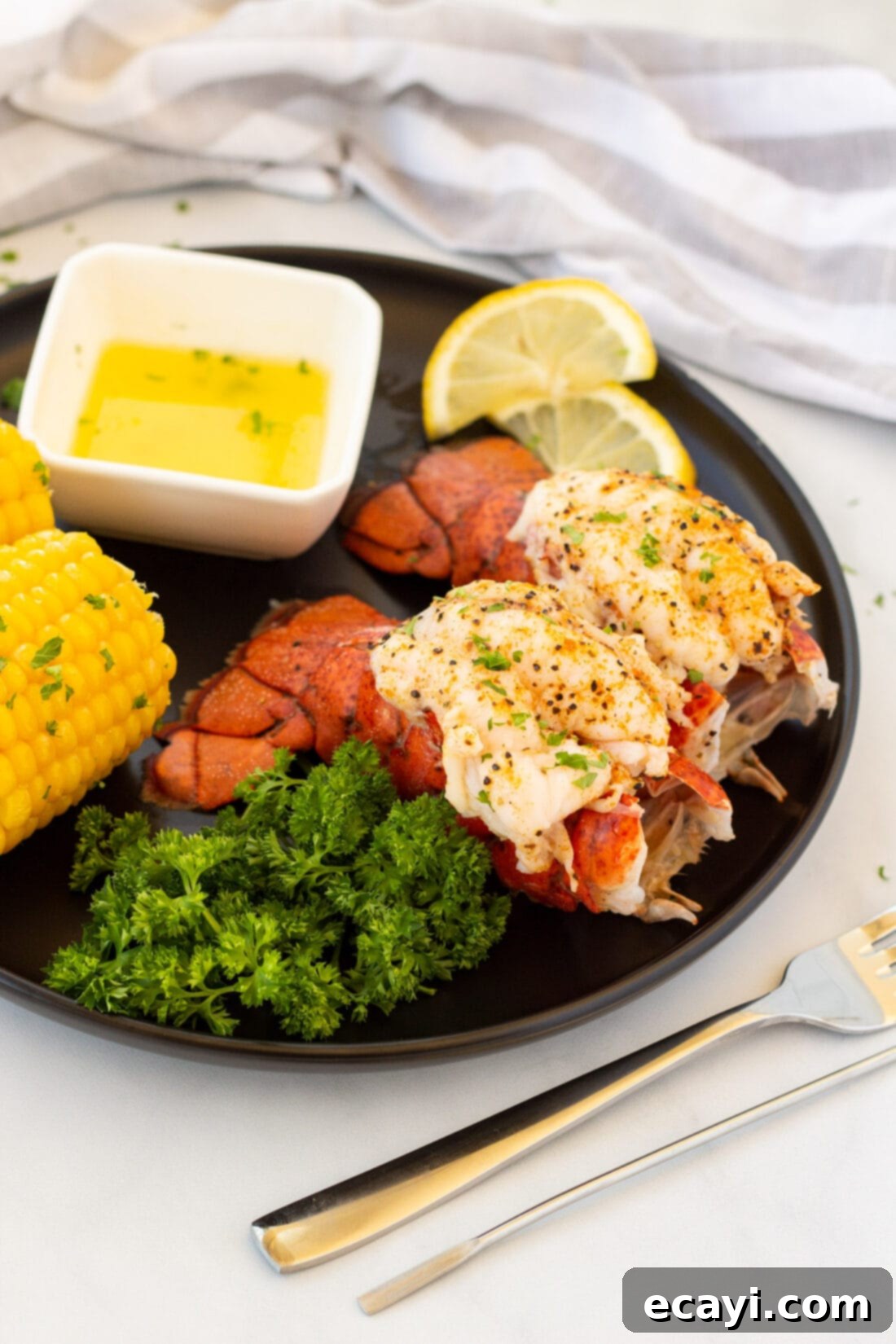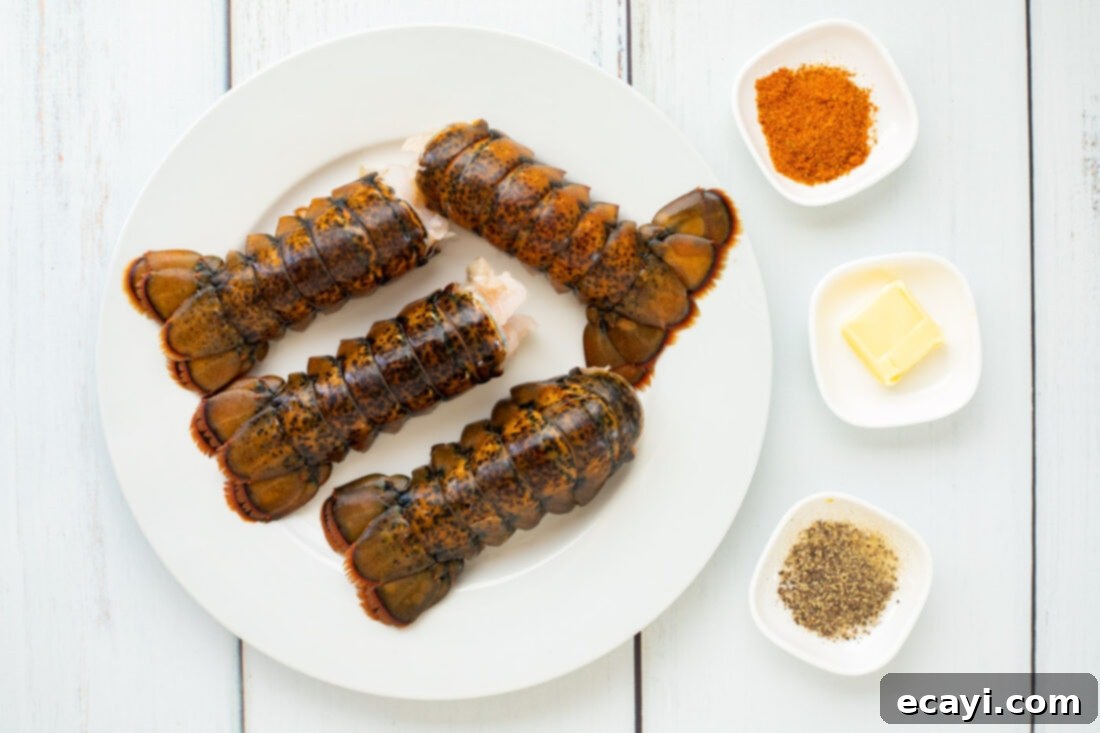Perfectly Steamed Lobster Tail: An Easy Recipe for Tender, Juicy Seafood at Home
Discover the ultimate method for preparing incredibly succulent, tender, and juicy lobster meat right in your own kitchen. Steaming lobster tails is not only remarkably quick and easy but also yields consistently delicious results in under 30 minutes from start to finish. This comprehensive guide will walk you through creating restaurant-quality steamed lobster tails, perfect for a luxurious dinner, a special celebration, or simply when you crave an impressive culinary centerpiece that’s surprisingly simple to achieve.

Why This Simple Steamed Lobster Tail Recipe Stands Out
Our steamed lobster tail recipe redefines effortless elegance in cooking. With just four core ingredients – premium lobster tails, rich melted butter, classic Old Bay seasoning, and a dash of freshly ground black pepper – you’re set to create an unforgettable meal. The power of Old Bay seasoning is truly transformative; its unique blend of herbs and spices perfectly complements the natural sweetness of the lobster without overpowering it, ensuring every bite is bursting with savory, aromatic flavor. Beyond its incredible taste, this preparation method allows for a stunning “crowned” presentation, transforming a simple ingredient into a visual masterpiece that will impress any guest. All of this is achievable in less than half an hour, making gourmet dining accessible any night of the week, whether you’re a seasoned chef or a home cook looking to elevate your skills.
One of the most significant advantages of steaming lobster tails is how gently it cooks the delicate meat, naturally releasing it from its shell. This makes serving incredibly convenient and mess-free, especially if you plan to incorporate the luscious lobster meat into other culinary creations. Imagine using this perfectly steamed lobster in decadent dishes like creamy lobster rolls, savory lobster tacos, hearty chowders, rich bisques, or even as a luxurious substitute for crab in recipes such as our popular air fryer crab cakes. While the meat can be easily removed after steaming for these uses, today we’re focusing on a show-stopping presentation. We’ll guide you through carefully removing the meat and elegantly “crowning” it atop the shell before steaming. This not only makes for easier access to the meat but also creates that signature, restaurant-worthy visual appeal that signals a truly special dining experience, making your dish look as good as it tastes.
Steaming is inherently a superior cooking method for lobster when compared to alternatives like boiling or grilling. Unlike boiling, which can sometimes leach flavor and waterlog the delicate meat, steaming locks in the natural juices and sweetness. Grilling or broiling, while delicious, carries a higher risk of drying out the lobster if not timed to perfection. The gentle, moist heat of steaming ensures that your lobster tails are consistently moist, sweet, tender, and never rubbery. It’s the optimal technique for highlighting the intrinsic quality and delicate texture of fresh lobster, guaranteeing a melt-in-your-mouth experience every time.

Essential Ingredients for Your Steamed Lobster Tails
Gathering your ingredients is the straightforward first step to a flawless and flavorful steamed lobster experience. This recipe calls for minimal items, allowing the natural, exquisite flavor of the lobster to shine brightest. You’ll find all precise measurements, specific ingredient details, and comprehensive instructions in the printable recipe version conveniently located at the end of this post. For now, here’s a quick overview of what you’ll need to prepare this exquisite seafood dish, ensuring you have everything on hand before you begin cooking.

Ingredient Spotlight: Tips for Selection and Flavor Variations
LOBSTER TAILS – The absolute key to exceptional steamed lobster begins with selecting the finest tails. We highly recommend opting for frozen lobster tails and planning ahead to defrost them properly overnight in the refrigerator. This slow thawing process helps maintain their delicate texture and prevents moisture loss. Crucially, avoid purchasing pre-thawed lobster tails from the store, as their freshness can often be compromised. When preparing your tails, it’s essential to inspect them thoroughly: if you happen to observe a dark line running through the flesh after cutting open the shell, this indicates the digestive tract, and it must be carefully removed before cooking to ensure the purest flavor and most enjoyable eating experience. Prioritize tails that feel firm to the touch and show no signs of discoloration. While various sizes work, smaller tails (around 3-4 oz each) tend to cook more evenly and remain slightly more tender, though larger tails can certainly be used with minor adjustments to steaming time and careful monitoring of internal temperature.
BUTTER – High-quality unsalted butter is an absolutely essential companion for serving steamed lobster. It melts beautifully over the hot, succulent lobster meat, adding a rich, luxurious finish and enhancing its inherent sweetness. Using unsalted butter is preferred, as it gives you complete control over the overall saltiness of your dish, especially when you’re already using a seasoned salt blend like Old Bay. If salted butter is all you have on hand, simply reduce the amount of Old Bay seasoning slightly to balance the flavors. Consider clarifying your butter for an even purer, richer dipping experience, or infuse it with minced garlic and fresh herbs for an extra layer of gourmet flavor.
SEASONING – Old Bay seasoning is a time-honored, classic choice for seafood for an excellent reason – its unique and perfectly balanced blend of 18 herbs and spices, including celery salt, paprika, and red pepper, perfectly complements the delicate nature of seafood. It provides a savory, slightly spicy, and aromatic profile that enhances rather than overwhelms the lobster. However, if Old Bay isn’t to your taste or readily available, there are fantastic alternative seasoning options. Cajun seasoning offers a bolder, spicier kick for those who enjoy heat, while a simple homemade mixture of garlic powder, onion powder, smoked paprika, and a pinch of cayenne pepper can also create a wonderfully flavorful crust. Feel free to experiment with your own favorite seafood seasoning blends to customize the taste precisely to your preference. A final squeeze of fresh lemon juice after steaming also brightens and lifts all the flavors beautifully, adding a touch of acidity that cuts through the richness of the butter.
Step-by-Step Guide: Crafting Your Perfect Steamed Lobster Tail
These detailed step-by-step photos and instructions are provided to help you visualize each crucial stage of this recipe, ensuring confidence in your cooking. For your convenience, you can easily jump to the printable recipe card at the bottom of this post, complete with all exact measurements and concise instructions for quick reference.
- Prepare the Lobster Tails: Begin by thoroughly rinsing your defrosted lobster tails under cold running water. This helps remove any lingering bits of shell or impurities. Afterwards, pat them completely dry with paper towels. This step is crucial, as a dry surface allows for optimal seasoning adherence and promotes even cooking, preventing a watery texture.
- Cut the Shell: Using a sturdy and sharp pair of kitchen shears, carefully cut down the exact center of the hard top shell of each lobster tail. Start from the thickest part near the head and stop just before you reach the tail fin, ensuring you leave the very end segment of the shell intact. Exercise caution to avoid cutting into the delicate meat itself during this initial incision.
- Loosen and Lift the Meat: Gently turn the lobster tail over, exposing the underside. Using gloved hands (a wise recommendation from Chef Antoine for safe handling of raw seafood), carefully loosen the meat from the inside of the shell. Start from the head end and work your way down, gently prying the meat free while keeping it securely attached at the base, near the tail fin.
- The Crowning Technique: With the lobster meat largely detached but still connected at the tail, carefully lift the entire piece of lobster meat upwards. Then, gently press the empty shell halves back together underneath the lifted meat, effectively creating a sturdy, elegant platform. Rest the lifted lobster meat on top of this closed shell. This elegant presentation is known as “crowning,” making the lobster look larger, more appealing, and significantly easier to eat.
- Season Generously: Now it’s time to impart incredible flavor! Season both sides of the exposed lobster meat generously with Old Bay seasoning and freshly ground black pepper. To ensure a truly balanced and flavorful experience, we recommend seasoning both the top and underside. To do this effectively, after crowning the meat, carefully flip the tail upside down so the crowned meat rests on your clean work surface. Season the underside of the meat with Old Bay and pepper, then gently return it to its crowned position and season the top exposed side. This two-sided seasoning ensures maximum taste in every bite.
- Arrange in Steamer: Carefully place your beautifully crowned and seasoned lobster tails into the top basket of your steam pot. Ensure they are arranged in a single layer, with sufficient space between each tail. This allows the steam to circulate evenly and thoroughly around each piece, guaranteeing perfect cooking without overcrowding.
- Add Butter: Prepare your butter by cutting it into thin slivers or small pats. Place one or two slivers directly on top of the crowned meat of each lobster tail. As the lobster steams, this butter will slowly melt, basting the meat and adding an extra layer of rich flavor, moisture, and a glossy sheen that enhances both taste and appearance.
- Boil the Water: In the bottom section of your steam pot, add enough water (typically 1-2 inches) so that it doesn’t quite touch the bottom of the steamer basket once assembled. Bring this water to a vigorous, rolling boil over high heat, creating a powerful source of steam.
- Steam the Lobster: Once the water is boiling rapidly, carefully place the top steamer basket, containing your seasoned lobster tails, firmly and securely over the bottom pot. Immediately reduce the heat to low. This is crucial to ensure the water continues to simmer gently, producing a steady stream of steam, but not boiling so aggressively that it splashes the lobster meat. Cover the pot tightly with a lid to trap all the steam effectively, which is key to efficient and even cooking.
- Cook to Perfection: Steam the lobster tails for approximately 8-10 minutes. The exact timing may vary slightly depending on the precise size and thickness of your tails; generally, a good rule of thumb is 1-1.5 minutes per ounce of lobster meat. You’ll know they’re done when the shells turn a vibrant, bright red color and the meat becomes opaque and firm to the touch.
Frequently Asked Questions & Expert Tips for Steaming Lobster
To maintain optimal freshness, flavor, and texture, store any leftover steamed lobster tails promptly in an airtight container. Keep this container in the refrigerator, where the lobster will remain good for up to 3-4 days. For an added layer of protection against drying out and absorbing other refrigerator odors, you can also wrap individual lobster tails securely in aluminum foil or plastic wrap before placing them in the container. When you’re ready to enjoy them again, gentle reheating methods like steaming for a few minutes or a quick sauté in butter are ideal to prevent the delicate meat from becoming tough or rubbery. Avoid microwaving, as it can quickly overcook and ruin the texture.
Lobster tail is perfectly cooked, safe, and at its most tender when its internal temperature reaches 145°F (63°C), as accurately measured with an instant-read thermometer. While it might be tempting to peek and check frequently, it’s generally best to cook according to the recommended directions and only check for doneness once the allotted cooking time is complete. Opening the steam pot during the cooking process allows precious steam to escape, which can significantly prolong cooking time and negatively affect the final texture of the lobster. Remember, overcooking is the biggest pitfall when preparing lobster; it will inevitably lead to rubbery, dry, and less flavorful meat. Trust the timing guidelines, and then verify with a thermometer at the very end for consistently perfect results.
For the absolute best results when steaming, we highly recommend looking for cold-water lobster tails. Varieties from regions like Maine, Canada, or South Africa are particularly prized for their sweeter, firmer, and more succulent meat compared to their warm-water counterparts. As previously advised, it’s always best to purchase these tails frozen if possible and then thaw them slowly overnight in the refrigerator. This controlled thawing process is crucial for maintaining the lobster’s premium quality, delicate texture, and optimal flavor profile. Always choose tails that appear vibrant, feel firm, and have no noticeable discoloration.
Absolutely! While plain water works perfectly well and allows the lobster’s natural flavor to shine, you can certainly infuse additional layers of flavor into your lobster by adding aromatic ingredients to the steaming water. Consider a splash of dry white wine (like Chardonnay or Sauvignon Blanc), a few fresh lemon slices or lemon peels, sprigs of fresh herbs (such as parsley, thyme, or dill), or even a crushed garlic clove or two. These additions will subtly perfume the steam, imparting delicate, complementary flavors to the lobster meat and enhancing the overall sensory experience without overwhelming its inherent taste. Experiment to find your favorite aromatic blend!

Elevate Your Meal: Delicious Serving Suggestions for Steamed Lobster
Steamed lobster tails are inherently luxurious and elegant, making them an ideal centerpiece for special celebrations, romantic dinners, holiday feasts, or simply whenever you desire to add a gourmet touch to your weeknight meal. The versatility of lobster means it pairs beautifully with a wide array of complementary side dishes, allowing you to customize your dining experience. For a truly classic and elegant presentation, serve your perfectly steamed lobster tails with fresh lemon wedges, enabling diners to add a bright, zesty finish that beautifully cuts through the richness of the meat. A small ramekin of warm, melted butter, perhaps infused with finely minced garlic, a sprinkle of fresh parsley, or a hint of cayenne pepper, is an absolute must for dipping – it’s a match made in culinary heaven that enhances every tender bite!
To round out your meal with comforting and satisfying sides, consider serving fluffy baked potatoes, creamy mashed potatoes, or even a decadent potato gratin. For a touch of sweetness, vibrant color, and contrasting texture, fresh vegetables are always a superb choice: serve with grilled asparagus, tender green beans, succulent corn on the cob, or a medley of other steamed seasonal vegetables. Warm, crusty artisan bread or soft, homemade biscuits are excellent for soaking up any extra butter or lobster juices. A light, crisp leafy green salad with a bright vinaigrette dressing can provide a refreshing counterpoint to the richness of the seafood. For the perfect beverage pairing, a chilled glass of dry white wine, such as Chardonnay, Sauvignon Blanc, or Pinot Grigio, beautifully complements the delicate flavors of the lobster. Whether you keep it elegantly simple or create an elaborate, multi-course spread, perfectly steamed lobster tails promise an unforgettable and truly impressive dining experience for all.
Explore More Delicious Seafood Recipes
If you love seafood as much as we do, you’re in for a treat! After mastering the art of perfectly steamed lobster tails, we invite you to dive into our collection of other fantastic seafood creations. From light and fresh appetizers to rich and comforting main courses, there’s a recipe here to satisfy every craving and expand your culinary repertoire with exciting flavors from the sea.
- Crab Dip
- Fish Tacos
- Lobster Mac and Cheese
- Shrimp Kabobs
- Maple Soy Salmon
- Skillet Broiled Cod
- Fried Crab Legs
- Air Fryer Crab Cakes
- Lobster Roll
- Lobster Risotto
I’m passionate about baking and cooking, and it brings me immense joy to share my kitchen experiences and delicious recipes with all of you! Remembering to check back for new culinary inspiration every day can be challenging, which is why I offer a convenient newsletter delivered directly to your inbox each time a new recipe is posted. Simply subscribe today and start receiving your free daily recipes, making it easier than ever to discover your next favorite dish and embark on new cooking adventures!

Steamed Lobster Tail Recipe
IMPORTANT – Don’t forget to check out the Frequently Asked Questions and Expert Tips section within the main blog post for valuable insights and answers to common queries that will enhance your cooking!
Print It
Pin It
Rate It
Save ItSaved!
Ingredients
- 4 lobster tails (approximately 3 oz each, for a total of 12 oz)
- ½ Tablespoon unsalted butter
- Old Bay seasoning (to taste)
- freshly ground black pepper (to taste)
Tools You’ll Need
-
Steam pot (5-7 quarts capacity, with steamer basket)
-
Kitchen shears
-
Vinyl gloves
-
Instant-read thermometer (optional, but recommended for perfect doneness)
Chef’s Notes & Pro Tips
- When cutting open the shell, always carefully remove the dark digestive tract if it’s visible in the lobster flesh.
- Leftover steamed lobster can be safely stored in an airtight container in the refrigerator for 3-4 days. For best results, wrap individually in foil.
- Lobster tails are perfectly cooked and at their prime when they reach an internal temperature of 145°F (63°C) as measured with an instant-read thermometer.
- Avoid the temptation to open the steam pot frequently during cooking, as this releases steam and can prolong cooking time while risking a tough texture.
- Overcooking is the primary culprit for rubbery, dry lobster meat. Trust the timing and temperature guidelines provided.
- For optimal flavor and texture, ensure your lobster tails are fully defrosted before beginning the preparation process.
- Experiment with adding aromatics like lemon slices, fresh herb sprigs, or a splash of white wine to the steaming water for infused flavor.
Instructions
-
Rinse the lobster tails thoroughly under cold water, then pat them completely dry with paper towels.
-
Using kitchen shears, carefully cut down the center of the top shell of each lobster tail, stopping just before the tail fin.
-
Turn the tail over. With gloved hands, gently loosen and lift the meat from the shell, keeping it attached at the tail fin.
-
Lift the meat and gently close the empty shell beneath it, resting the meat on top of the closed shell. This is the “crowning” technique.
-
Season both sides of the exposed lobster meat with Old Bay seasoning and black pepper. To season the underside, briefly flip the crowned tail so the meat rests on your work surface, season, then return it to its crowned position and season the top.
-
Carefully place the crowned lobster tails into the top basket of your steam pot, ensuring they are in a single layer.
-
Cut the butter into thin slivers and place one sliver on top of the crowned meat of each lobster tail.
-
Bring water to a vigorous boil in the bottom section of the steam pot (ensure water does not touch the steamer basket).
-
Place the top steamer basket over the boiling water. Reduce heat to low, ensuring a steady steam, and cover the pot tightly.
-
Steam for 8-10 minutes, or until the shells are bright red and the internal temperature of the meat reaches 145°F (63°C). Serve immediately with melted butter and lemon wedges.
Nutrition Information
The recipes on this blog are meticulously tested with a conventional gas oven and gas stovetop to ensure accuracy. It’s important to acknowledge that some ovens, particularly older models, may heat and bake inconsistently. We highly recommend using an inexpensive oven thermometer to confirm your oven is maintaining the correct temperature. If you opt to use a toaster oven or countertop oven, please be aware that heat distribution might differ from a full-sized conventional oven, potentially requiring adjustments to your cooking or baking times. For pressure cooker, air fryer, slow cooker, or other appliance-specific recipes, a direct link to the appliances we utilize is provided within each respective recipe. Lastly, for baking recipes where measurements are specified by weight, please note that using volumetric cups instead may yield different results, and we cannot guarantee success with such substitutions.
